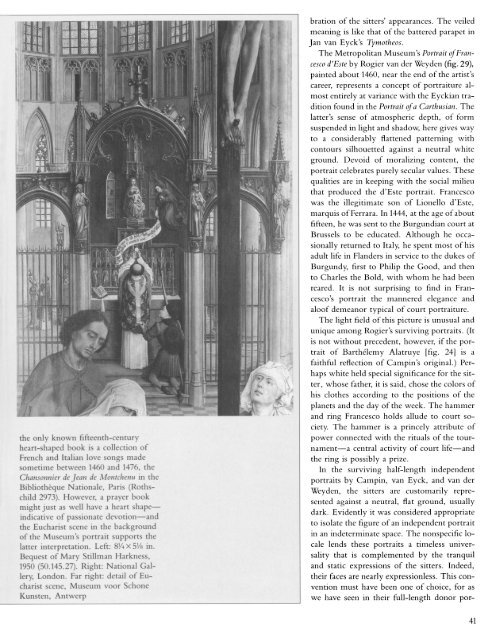Early Flemish Portraits 1425-1525: The Metropolitan Museum of Art ...
Early Flemish Portraits 1425-1525: The Metropolitan Museum of Art ...
Early Flemish Portraits 1425-1525: The Metropolitan Museum of Art ...
You also want an ePaper? Increase the reach of your titles
YUMPU automatically turns print PDFs into web optimized ePapers that Google loves.
the only known fifteenth-centur<br />
heart-shaped book is a collection<br />
French and Italian love songs ma<br />
sometime between 1460 aind 147<br />
Chansonnier de jean de Montchenu<br />
Bibliotheque Nationale, Paris (<br />
child 2973). However, a prayer b,<br />
might just as well have a heart st<br />
indicative <strong>of</strong> passionate devotion<br />
the Eucharist scene in the backgr<br />
<strong>of</strong> the <strong>Museum</strong>'s portrait suppor<br />
latter interpretation. Left: 84 x 5<br />
Bequest <strong>of</strong> Mary Stillman Harkn<br />
1950 (50.145.27). Right: National<br />
lery, London. Far right: detail <strong>of</strong><br />
charist scene, <strong>Museum</strong> voor Schi<br />
Kunsten, Antwerp<br />
::: : :<br />
bration <strong>of</strong> the sitters' appearances. <strong>The</strong> veiled<br />
meaning is like that <strong>of</strong> the battered parapet in<br />
Jan van Eyck's Tymotheos.<br />
<strong>The</strong> <strong>Metropolitan</strong> <strong>Museum</strong>'s Portrait <strong>of</strong>Francesco<br />
d'Este by Rogier van der Weyden (fig. 29),<br />
painted about 1460, near the end <strong>of</strong> the artist's<br />
career, represents a concept <strong>of</strong> portraiture al-<br />
most entirely at variance with the Eyckian tradition<br />
found in the Portrait <strong>of</strong> a Carthusian. <strong>The</strong><br />
latter's sense <strong>of</strong> atmospheric depth, <strong>of</strong> form<br />
suspended in light and shadow, here gives way<br />
to a considerably flattened patterning with<br />
contours silhouetted against a neutral white<br />
ground. Devoid <strong>of</strong> moralizing content, the<br />
portrait celebrates purely secular values. <strong>The</strong>se<br />
qualities are in keeping with the social milieu<br />
that produced the d'Este portrait. Francesco<br />
was the illegitimate son <strong>of</strong> Lionello d'Este,<br />
marquis <strong>of</strong> Ferrara. In 1444, at the age <strong>of</strong> about<br />
fifteen, he was sent to the Burgundian court at<br />
Brussels to be educated. Although he occasionally<br />
returned to Italy, he spent most <strong>of</strong> his<br />
adult life in Flanders in service to the dukes <strong>of</strong><br />
Burgundy, first to Philip the Good, and then<br />
to Charles the Bold, with whom he had been<br />
reared. It is not surprising to find in Francesco's<br />
portrait the mannered elegance and<br />
alo<strong>of</strong> demeanor typical <strong>of</strong> court portraiture.<br />
<strong>The</strong> light field <strong>of</strong> this picture is unusual and<br />
unique among Rogier's surviving portraits. (It<br />
is not without precedent, however, if the portrait<br />
<strong>of</strong> Barthelemy Alatruye [fig. 24] is a<br />
faithful reflection <strong>of</strong> Campin's original.) Perhaps<br />
white held special significance for the sitter,<br />
whose father, it is said, chose the colors <strong>of</strong><br />
his clothes according to the positions <strong>of</strong> the<br />
planets and the day <strong>of</strong> the week. <strong>The</strong> hammer<br />
and ring Francesco holds allude to court society.<br />
<strong>The</strong> hammer is a princely attribute <strong>of</strong><br />
power connected with the rituals <strong>of</strong> the tournament-a<br />
central activity <strong>of</strong> court life-and<br />
the ring is possibly a prize.<br />
In the surviving half-length independent<br />
portraits by Campin, van Eyck, and van der<br />
Weyden, the sitters are customarily represented<br />
against a neutral, flat ground, usually<br />
dark. Evidently it was considered appropriate<br />
to isolate the figure <strong>of</strong> an independent portrait<br />
in an indeterminate space. <strong>The</strong> nonspecific locale<br />
lends these portraits a timeless universality<br />
that is complemented by the tranquil<br />
and static expressions <strong>of</strong> the sitters. Indeed,<br />
their faces are nearly expressionless. This convention<br />
must have been one <strong>of</strong> choice, for as<br />
we have seen in their full-length donor por-<br />
41

















